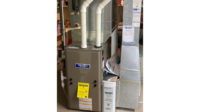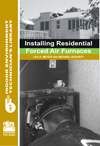High-end furnaces feature an array of benefits and options to fit any consumer’s needs and wants. Consumers are becoming more self-educated about HVAC systems and how they perform, according to Jill A. Murphy, senior product marketing manager- heating, at Lennox.“This is leading to more questions about high-end furnaces and their benefits,” she said. "We have seen an upward trend in terms of demand for these products.”
The Air-Conditioning, Heating, & Refrigeration Institute (AHRI) Monthly Shipments confirm Murphy’s statement. AHRI reported that U.S. shipments of gas warm air furnaces for June 2017 increased 9.8 percent, while oil warm air furnace shipments increased 21.7 percent.
“A good economy with high consumer confidence makes it easier to sell the more expensive features and benefits that make up high-end furnaces,” explained David Palazzolo, senior product manager, Split Systems, Daikin North America LLC.
However, cost will always be a barrier to the high-end furnace market, noted Jeff Tyminski, director of product management, Ducted Air Handlers and Heat Pumps, Trane and American Standard.
“High-end furnaces tend to be attached to a high-end HVAC system,” he said. “High-end systems are never going to be the majority of the industry, especially in the replacement market where the average homeowner isn’t prepared for the high cost of HVAC system replacement.”
So what exactly constitutes a high-end furnace? According to Murphy, a high-end furnace should encompass high-efficiency, comfort, quiet operation, quality and reliability all in one system, along with smart communication capabilities.
“Furnaces are typically categorized as low-, mid-, and high-end,” she said. “At Lennox, we have products that fall into each one of these tiers. The Dave Lennox Signature Collection is our high-end furnace collection. In this line, we focus on some of the most precise, efficient and quietest heating systems you can buy.”
Furnaces are differentiated in how they package comfort, efficiency and peace of mind for the homeowner, Tyminski explained.
“For comfort, most people only think about a furnace providing warm air during the winter time,” he said. “To that end, furnace heating can be single-stage, two-stage or fully modulating. What many customers don’t think about is how a furnace works to cool their house during the summer time — it’s the furnace that moves the air through the cooling coil and pushes that cool air throughout the house. Much like in heating, cooling can be either single-stage, two-stage, and fully variable. Not all furnaces are capable of working in all of these stages. Most customers view a furnace with only single-stage heating and cooling to be a ‘basic’ furnace, and two-stage or fully modulating/variable speed to be ‘high-end.’
“Efficiency is another way furnaces differentiate themselves, and there are two types of furnace efficiency: fuel efficiency and electrical efficiency,” Tyminski continued. “Electrical efficiency of a furnace shows up in higher SEER ratings, which have the potential to save homeowners on their monthly electric bill in both the heating and cooling seasons. The fuel efficiency of a furnace is measured by AFUE and may influence a homeowner’s monthly gas bill during the heating season. Traditionally, high-end equipment was synonymous with high fuel efficiency, but manufacturers today are recognizing that different markets have different needs, and a high-end furnace has to have the right package or combination of fuel efficiency as well as comfort and homeowner peace of mind.”
Palazzolo also cited AFUE ratings as a differentiator of high-end furnaces.
“The U.S. Department of Energy (DOE) mandates the lowest efficiency allowed by law,” he said. “Today, the lowest efficiency allowed in the U.S. is 80 percent AFUE, and in Canada, 90 percent AFUE. A higher AFUE furnace is also better for the environment due to more efficient and cleaner fuel consumption. Of course, higher efficiency furnaces will also typically cost more, so there is a tradeoff between the first cost and the payback that can be recouped from using less gas. Higher efficiency furnaces, such as Daikin’s DM97MC, can achieve as high as 98 percent AFUE, which means it is burning the fuel almost to complete efficiency.”
Smarter Systems
According to Murphy, the biggest trend impacting the high-end furnace market is a continued focus on ‘smart’ technology and how controls integrate with the products themselves.
“In past years, we have seen a race within the industry to achieve better efficiency with higher AFUE ratings, and some are now reaching 99 percent,” she said. “This marks a shift to innovative technology, and how it integrates with HVAC equipment is one of the largest new trends.”
Tyminski agreed, saying smart technology is definitely having an impact with features like self-diagnostics.
“The largest trend is in the area of self-configuration and self-diagnostics,” he said. “Our Nexia Dealer Diagnostics portal enables homeowners and their dealers to view key performance characteristics of the system to ensure the unit is operating as expected. This provides a very different owners experience for a homeowner, who can be confident their equipment is operating as expected, and enables the dealer base to deliver a better and more cost-effective consumer experience. As technology becomes more mature and comes down in price, adoption has been increasing. We expect to see more self-configuring and remote diagnostic-capable equipment in the coming years.”
High−Efficiency Market
Additionally, Tyminski is seeing more high-end furnaces in new construction.
“High-efficiency homes are becoming more popular and have very special needs compared to more traditional home construction, and that’s driving the use of higher end equipment in new construction,” he said. “Building codes and regulations are having an effect on new construction as builders are either being directly mandated to use higher efficiency furnaces or they are learning that high-efficiency HVAC systems help meet building efficiency goals.”
Palazzolo said high-efficiency gas furnace sales have remained steady over the past few years due to fairly steady fuel prices.
“If natural gas prices were to rise substantially, there would be a natural increase in higher efficiency gas furnaces,” he noted. “The mix of 80 percent versus 90 percent furnace sales is about a 50/50 split, which has held relatively steady at this rate over the past five years. Gas heating is the most common form of heating homes in North America as compared to heating with oil, heat pumps, or electric strip heat. Heat pumps are the second most common, which heat and cool using electricity only. Heat pumps have historically been used more in the southern U.S. due to lower heating efficiency performance in colder regions. More recently, however, heat pump technology has improved to where heating efficiently can be achieved even in areas of Canada with very low temperatures. This trend is driving more sales towards heat pumps and away from furnaces in general.”
Other trends that go along with high-end furnaces include features such as variable speed airflow, variable heat output and add-on Indoor Air Quality (IAQ) devices such as filtration, humidification and dehumidification, according to Palazzolo.
“Variable speed blowers can provide additional comfort by delivering air slower, with less noise, when less heating is required,” he said. “Slowly ramping the blower speed up and down to meet the thermostat demand provides fewer temperature swings and drafts. Variable or modulating gas valves work in conjunction with the variable speed blowers to automatically vary the amount of gas and heat delivered as compared to a basic on and off, fixed heat furnace.
“In addition to the heat pump technology trend, comfort, home efficiency and air quality, as well as government programs such as Energy Star, have brought a heightened consumer awareness resulting in a steady increase in high-end systems and components,” Palazzolo added.
What’s Next
With the seemingly endless changes in technology, the next five years will be interesting for the high-end furnace market.
“Over the next several years, I see our industry focusing more on developing communicating systems, ‘smart’ functions, and increasing the comfort level that can be achieved by these products, especially in the premium category,” Murphy said.
The current trends push more systems sales and feature-rich accessories, which typically have high margins for both the wholesaler and their contractor customers, Palazzolo said.
“Distributors should recognize the trends and turn them to their advantage,” Tyminski said. “Targeted activities to drive adoption of dealer-diagnostics features will best position their dealer network for this emerging trend. In addition, an opportunity to refocus on the new construction segment can grow their business if you can connect with builders and contractors that are serving the high-performance home market and educating builders and contractors on both the features and benefits for the products that you carry, as well as what services the distributor can bring to the table.
“Additionally, the trend toward digital, which is driving both online consumer research and connected controls options, is modifying how consumers make purchase decisions,” he continued. “As a result, the historical weight of advertising, selling, and maintaining relationships with customers is different, and the digital influence should be considered. Wholesalers need to be prepared to evolve their business models to keep pace with these changes. Distributors want to prepare themselves and their dealers to continue to effectively capture consumers’ attention.”







